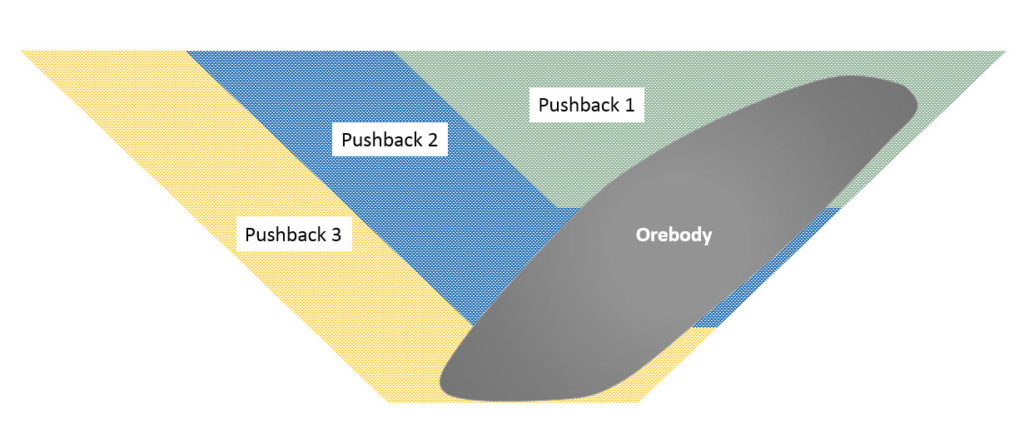In earlier articles we looked at a hierarchical mine planning process and how to measure spatial plan alignment between different levels in the hierarchy. The second article showed that getting the same tonnes and grade in a short-term plan as in its guiding long-term plan is not alignment.
Everyone agrees that the short-term plan should follow the long-term plan, but this doesn’t always work out as intended.
Alignment is spatial and we need to ensure that we are getting the same material from the same locations in both the short- and long-term plans. So how do we actually achieve alignment and have the short-term plan follow the long-term plan? I have discussed this topic with many mine planners who work on one or both sides of the tricky long-term/short-term planning equation. Most people will say that they need to have the short-term plan following the long-term plan. When I have asked how they actually do that, most will describe something along the lines of the following.
The Common Approach to Following the Long-term Plan
Once you have developed your strategic long-term plan, you can export just the reserves associated with the part of that plan that needs to be scheduled in more detail. For example, you can just export the first two years of reserves that are scheduled for mining from a 20 year plan. Then you import these reserves into your short-term planning package and schedule it out on a monthly basis. Sounds easy, right? It may sound easy, but in practice, this approach can create problems.
The common approach can run into problems when the 2 years of your long-term plan doesn’t fit into 24 monthly periods.
Think about a strategic mine plan that has a yearly increment of 24 Mt of ore related to the mill capacity. At a monthly level, your mill can process 2 Mt. However, you are not guaranteed to be able to find an operational plan that can achieve 2 Mt each and every month. That 24 Mt could be down in the bottom of a pushback like in the figure below and you may only start mining it at month 8 of 12. If so, you would only be able to achieve 5 months at 2 Mtpm, or 10 Mt. So what do you do when the 2 years of your long-term plan doesn’t fit into 24 monthly periods?
Alignment as a Constraint
If you are using an operational scheduling system like iGantt or Tempo that allows constraint-based optimization with blending, then a different approach is available to you. Your start point is the same as described above for exporting reserves from your long-term plan, with one small difference. You export out more material than you need to schedule. The reason for this is that, as we have seen above, you may not be able to fit the two years of the strategic plan perfectly into the first 24 months of the operational plan. But you want to fit in as much of it as possible to maximize alignment. The remainder of the operational plan is composed of material coming after the first 2 years of the strategic plan. To continue, I’ll describe a step-by-step recipe for using attribute blending constraints to achieve plan alignment.
- Export the first 3 years of your long-term plan.
- In the export, ensure you have 24 extra fields. Each field will correspond to a month in your short-term plan.
- If a block is scheduled in the first year of your long-term plan, make sure your export process will write 100 into the first 12 extra fields and 0 into the remaining 12. If a block is scheduled in the operational plan in one of the first 12 months, this value of 100 represents 100% plan alignment with respect to that block. The tonnage weighted average of all blocks in a period will be the spatial plan alignment in that period.
- If a block is scheduled in the second year of your long-term plan, make sure your export process will write 0 into the first 12 extra fields and 100 into the remaining 12.
- If a block is scheduled in the third year of your long-term plan, make sure your export process will write 0 into all 24 extra fields.
- For each of your extra fields, put in a minimum constraint related to your plan alignment kpis, e.g. 85%. What this constraint says is “I want at least 85% of the material in the short-term schedule to be mined in the same year as in the long-term schedule.”
- With your normal constraints in place like mining and milling, initiate the optimization.
A constraint-based approach ensures that a certain percentage of the material in the short-term schedule will be mined in the same year as in the long-term schedule.
If you cannot achieve a complete schedule for all months, you may need to reduce your plan alignment target. If you don’t want to do this, read on for a slightly different approach.
Alignment as a Goal
Treating alignment as a goal rather than as a constraint gives a better result.
Instead of treating alignment as a constraint, you can treat it as a goal. You don’t need to put all of those alignment constraints on as you can maximize alignment across your schedule instead of constraining it. To maximize anything in optimization, you need to put that “thing” into what is known as the objective function. You can think of it as the value for mining a block in a particular time period. Let’s see what the recipe looks like to get alignment into the objective.
- Export the first 3 years of your long-term plan.
- In the export, ensure you have 2 extra fields. Each field will correspond to a year in your long-term plan.
- If a block is scheduled in the first year of your long-term plan, make sure your export process will write 1 into the first extra field and 0 into the next.
- If a block is scheduled in the second year of your long-term plan, make sure your export process will write 0 into the first extra field and 1 into the next.
- If a block is scheduled in the third year of your long-term plan, make sure your export process will write 0 into both extra fields.
- For all 12 months of the first year, set the block objective to be a product of the first extra field (year one material) and the block tonnes. For the final 12 months, set the block objective to be a product of the second extra field and the block tonnes. With this configuration, you are now set up to optimize the tonnage weighted alignment of the short-term plan with the long-term plan.
- With your normal constraints in place like mining and milling, initiate the optimization.
The recipe pattern is similar, but has these differences:
- The number of extra fields goes from 24 to 2
- Constraints on extra fields are removed
- The optimization is driven by alignment
I hope this has helped you to answer that question of how to actually achieve alignment and have the short-term plan follow the long-term plan. If you have found this useful, feel free to share it with your colleagues. Comment or ask us any questions on plan alignment using the contact form below.

